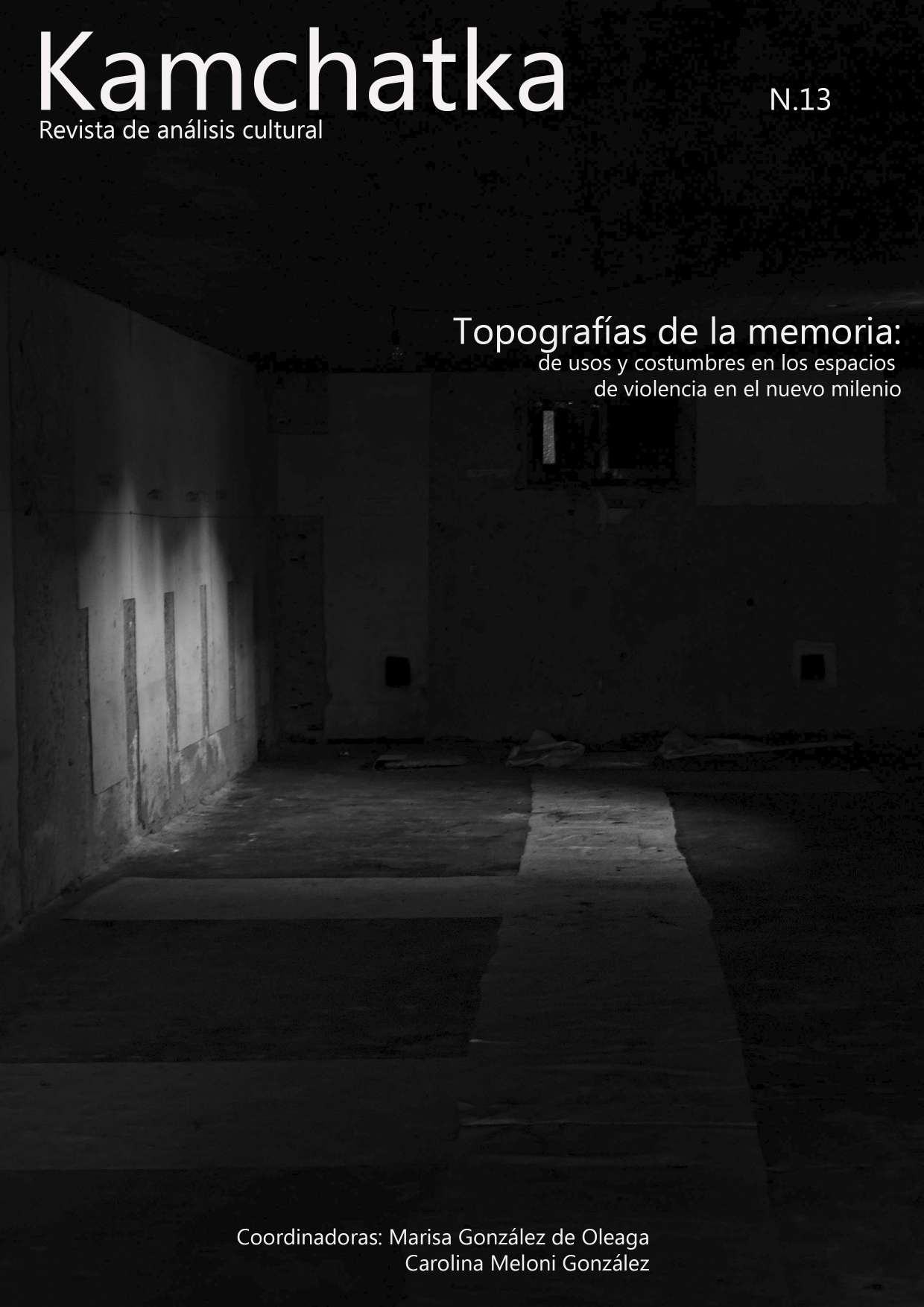Accusation and Therapy: The Gedenkstätten in Austria and Germany and the sitios de memoria in Argentina
DOI:
https://doi.org/10.7203/KAM.13.12578Keywords:
Memorial sites, Site of Memory, Argentine dictatorship, National Socialism Abstract
Abstract
The sitios de memoria established on sites of former Clandestine Centers of Detention, Torture and Annihilation during the last Argentine dictatorship (1976-1983) and the Gedenkstätten on sites of former nazi concentration camps in Germany and Austria are places in which a traumatic past for the victims and a past burdened with guilt of the perpetrators are remembered. They both carry an inherent duality within them: they can be places of (self)therapy or places of accusation; places to commemorate the victims or places of Mahnung, i. e. of appeal and monition, which focus on the perpetrators and their deeds. But the question is: under which circumstances does one aspect gain dominance over the other? The text tries to show that, while the Argentine sitios de memoria emphasize the (self)therapy of the affected society, the Gedenkstätten are dominated by a discourse that focusses on the accusation of the perpetrators. For this purpose, it outlines the different sociopolitical constellations under which the discourses about the past were established in post National Socialist societies and in post dictatorial Argentina, respectively. Finally, the text wants to show how these foundational moments influence in the subsequent unfolding and development of memory discourses and how all that is symbolically inscribed in the sites dealing with the commemoration of the past.
 Downloads
Downloads
 References
References
Adler, Tal (2016). “Die Ästhetik von Ordnungslosigkeit, Vernachlässigung und Solidarität. Zum selbständigen Gedenken in der KZ-Gedenkstätte Mauthausen”. Verein für Geschichtsforschung y Gedenken in österreichischen KZ-Gedenkstätten (ed.). Gedenkbuch für die Toten des KZ Mauthausen und seiner Außenlager, Band 1: Kommentare und Biografien. Viena: New Academic Press: 110-119.
Aquino, Leticia Inés; Duguine, Laura y Gavilán, Stella (2016). Informe técnico. Estado de conservación y planificación del traslado del material probatorio, tambores de 200 litros y fragmentos cementicios. Buenos Aires: Dirección Nacional de Sitios de Memoria. Inédito.
Basualdo, Victoria (2016). Responsabilidad empresarial en delitos de lesa humanidad. Represión a trabajadores durante el terrorismo de Estado. Posadas: EDUNAM.
BERMEJO, Benito (2015). El fotógrafo del Horror. La historia de Francisco Boix y las fotos robadas a los SS de Mauthausen. Barcelona: RBA Libros.
Calveiro, Pilar (2014). Poder y desaparición. Los campos de concentración en Argentina. Buenos Aires: Colihue.
Colombo, Pamela (2010). “Exhumaciones: (des)aparecidos o cuando la tierra se abre”. Navarro, María G. et al. (ed.). Claves actuales de pensamiento. Seminario Internacional de Jóvenes Investigadores (SIJI). Madrid–México: Plaza y Valdés Editores: 63-72.
CONADEP (2003). Nunca más. Informe final de la Comisión Nacional sobre la Desaparición de Personas. Buenos Aires: Eudeba.
Dürr, Christian (2016). “Von Mauthausen nach Gusen und zurück. Verlassene Konzentrationslager – Gedenkstätten – traumatische Orte”. Allmeier, Daniela et al. (ed.). Erinnerungsorte in Bewegung. Zur Neugestaltung des Gedenkens an Orten nationalsozialistischer Verbrechen. Bielefeld: Transcript: 145-165.
Dürr, Christian (2017). Memorias incómodas. El dispositivo de la desaparición y el testimonio de los sobrevivientes de los CCDTyE. Temperley: Tren en Movimiento.
Feierstein, Daniel (2007). El genocidio como práctica social. Entre el nazismo y la experiencia argentina. Buenos Aires: Fondo de Cultura Económica.
Feld, Claudia. “Imagen y testimonio frente a la desaparición forzada de personas en la Argentina de transición.” Kamchatka. Revista de análisis cultural 6 (2015): 687-715.
Foucault, Michel (1970). La arqueología del saber. Madrid, México, Bogotá, Buenos Aires: Siglo XXI.
Gatti, Gabriel. “Imposig Identity against Social Catastrophes. The Strategies of (Re)Generation of Meaning of the Abuelas de Plaza de Mayo (Argentina)”. Bulletin of Latin American Research 3, 31 (2002): 352-365.
Hopfer, Ines (2009). “Die Spur führt nach Graz. Auf der Suche nach den sterblichen Überresten eines NS-Opfers”. Bundesministerium für Inneres (ed.). KZ-Gedenkstätte Mauthausen – Mauthausen Memorial 2008. Forschung, Dokumentation, Information: 48-57.
Knigge, Volkhard (1996). “Vom Reden und Schweigen der Steine. Zu den Denkmalen auf dem Gelände ehemaliger nationalsozialistischer Konzentrations- und Vernichtungslager”. Weigel, Sigrid y Erdle, Birgit R. (ed.). Fünfzig Jahre danach. Zur Geschichte des Nationalsozialismus. Zürich: vdf Hochschulverlag: 193-234.
Knigge, Volkhard (2002). “Gedenkstätten und Museen”. Knigge, Volkhard y Frei, Norbert (ed.). Verbrechen erinnern. Die Auseinandersetzung mit Holocaust und Völkermord. München: C.H. Beck: 378-389.
Meloni, Carolina (2018). “Cadáveres insumisos. Hacia una ética del asedio y de la hospitalidad”. Inédito (texto cedido por la autora).
Mesa de Trabajo y Consenso Ex Centro Clandestino de Detención, Tortura y Exterminio “Olimpo” (s/f). Ex Centro Clandestino de Detención, Tortura y Exterminio “Olimpo”. Buenos Aires: Instituto Espacio para la Memoria.
Ministerio de Justicia y Derechos Humanos. Informe técnico. Buenos Aires, 30 de junio de 2017. Inédito.
Moon, Claire. “Human Rights, Human Remains: Forensic Humanitarianism and the Human Rights of the Dead”. International Social Science Journal 65/215-216 (2016): 49-63.
Perz, Bertrand (2006). Die KZ-Gedenkstätte Mauthausen 1945 bis zur Gegenwart. Innsbruck: Studienverlag.
Perz, Bertrand (2011). “Die Ausstellungen in den KZ-Gedenkstätten Mauthausen, Gusen und Melk”. Rupnow, Dirk y Uhl, Heidemarie (ed.). Zeitgeschichte ausstellen in Österreich: Museen – Gedenkstätten – Ausstellungen. Viena: Böhlau: 87-116.
Siebeck, Cornelia (2015). “50 Jahre ‘arbeitende’ NS-Gedenkstätten in der Bundesrepublik. Vom gegenkulturellen Projekt zur staatlichen Gedenkstättenkonzeption – und wie weiter?”. Gryglewski, Elke et al. (ed.). Gedenkstättenpädagogik. Kontext, Theorie und Praxis der Bildungsarbeit zu NS-Verbrechen. Berlín: Metropol: 19-43.
Downloads
Published
How to Cite
-
Abstract1197
-
Artículo (Español)753
Issue
Section
License
This journal provides an immediate free access to the content on the principle that freely make investigation available to the public, which promotes an increased global knowledge exchange.
Unless otherwise indicated, texts published in this journal are under the license Attribution-NonComercial 4.0 by Creative Commons. These texts may be copied, distributed and publicly communicated whenever the publication’s author and title are quoted and whenever they are not used for commercial purposes. In any case, intellectual property of the articles and its potential economic rights entirely belong to its authors.
The full license can be consulted on https://creativecommons.org/licenses/by-nc/4.0/. We encourage authors to disseminate papers published in Kamchatka. Journal of cultural analysis electronically, in institutional digital repository or in their websites.





